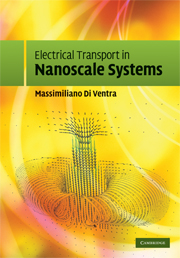Book contents
- Frontmatter
- Contents
- Preface
- 1 A primer on electron transport
- 2 Drude model, Kubo formalism and Boltzmann equation
- 3 Landauer approach
- 4 Non-equilibrium Green's function formalism
- 5 Noise
- 6 Electron-ion interaction
- 7 The micro-canonical picture of transport
- 8 Hydrodynamics of the electron liquid
- Appendices
- References
- Index
3 - Landauer approach
Published online by Cambridge University Press: 06 July 2010
- Frontmatter
- Contents
- Preface
- 1 A primer on electron transport
- 2 Drude model, Kubo formalism and Boltzmann equation
- 3 Landauer approach
- 4 Non-equilibrium Green's function formalism
- 5 Noise
- 6 Electron-ion interaction
- 7 The micro-canonical picture of transport
- 8 Hydrodynamics of the electron liquid
- Appendices
- References
- Index
Summary
I am now ready to move on to the transport theories based on Viewpoint 2: the field is a consequence of carrier flow (see Sec. 1.6). Seeds of this approach are almost as old as quantum mechanics. For instance, one of the first applications of scattering theory to determine the electrical resistance at the contact between two conductors can be found in the work of J. Frenkel published in 1930 (Frenkel, 1930). Here, the calculation of the current is done by assuming that electrons on the two sides of the contact, at their own local equilibrium distribution, have a finite transmission probability to tunnel across the potential barrier induced by the junction. This result anticipated the concept that, under specific conditions, the conductance of a given system sandwiched between electrodes can be related to its transmission properties, namely to the probability for electrons to “cross” the system in going from one electrode to the other.
However, the idea that scatterers can induce, self-consistently, local fields which “act back” on the carrier dynamics was pioneered by Landauer (Landauer, 1957), and has contributed tremendously to our understanding of electron transport in mesoscopic and nanoscopic systems. It is a major conceptual departure from the theories I have discussed in the previous chapter.
Another fundamental result of the Landauer approach is that a finite resistance emerges even if the transmission probability of the sample is unity; a fact I have anticipated – though from a different perspective – in Sec. 2.3.4. This result requires a non-trivial understanding of the role of the sample versus all other elements of an electrical circuit (Imry, 1986).
- Type
- Chapter
- Information
- Electrical Transport in Nanoscale Systems , pp. 101 - 208Publisher: Cambridge University PressPrint publication year: 2008
- 1
- Cited by



